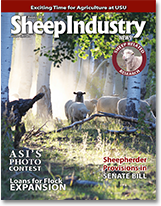Exciting Time for Ag at USU
By AMY TRINIDAD
Sheep Industry News Editor
(Aug. 1, 2013) Many know the significance of Noelle Cockett’s, Ph.D., work on the mapping of the sheep genome; however, many in the industry may not be aware of the progress she has made within the College of Agriculture and Applied Sciences at Utah State University (USU). An internationally distinguished sheep genetics researcher with an active research program, Cockett has been an integral component of a new agricultural sciences building along with a new animal sciences facility on campus.
As the dean and vice president of Agriculture and Extension and the administrator of the Utah Agricultural Experiment Station (UAES), Cockett spent eight years planning and fundraising for the new ag building which officially opened its doors on Feb. 29. The $43.1 million building was funded through the Utah State Legislature after approval in 2010. It plays host to high-tech teaching and research labs for students and faculty, computer labs, classroom space and houses the faculty and administrative office of the College of Agriculture, USU Extension, the UAES, the Western Sustainable Agriculture Research and Education Center, the Western Rural Development Center and the USU Botanical Center.
“We were able to begin construction in 2010, and I have to say the climate for building construction couldn’t have been more favorable,” explains Cockett, saying they were able to really stretch the construction dollars. The building was designed and constructed adhering to Leadership in Energy and Environmental Design (LEED) certification guidelines. LEED is an internationally recognized mark of excellence and provides building owners and operators with a framework for identifying and implementing practical and measurable green building design, construction, operations and maintenance solutions. Solar panels were placed on the south face of the building to provide shade from the southern sun as well as produce energy. The solar panels were added to the plans after a grant from the state of Utah was awarded to support innovation for building integrated solar systems.
Cockett explains that the conference room of the ag building is of great significance to her as it is named after the Utah Wool Growers Association. “I would like to recognize the Utah Wool Growers Association for helping with the building,” she says, “for both supporting its funding and also the beautiful conference room. It really means a lot to me. I feel like it is recognition for the work I have been able to do that they wanted to name the conference room.”
The new construction within the College of Agriculture doesn’t stop there. A few years back, USU received a $10 million allocation again from the Utah State Legislature to consolidate all of the animal science facilities into one location. Pertinent to the sheep industry, a new facility for sheep research and teaching was built. Again the dollars were stretched as the farm and animal crew did a lot of the work on the buildings.
“As a result, we now have a really high-end sheep facility. It is really easy for only a few people to work all the sheep at once with good chutes and gates. In addition, we also built two goat facilities since we are doing more with goats to clone and create models for biomedical research.”
Another exciting development at USU is the opportunity for students to earn a doctorate of veterinarian medicine in conjunction with Washington State University (WSU). The program, which begin last year with 20 Utah students and 10 non-resident students, requires students to take the first two years of programming at USU and the last two years students attend WSU. “They get a USU and WSU degree,” says Cockett, “which is very exciting.”
Amongst all of the new construction, Cockett has made progress on the map of the sheep genome. In October of last year, version 3.1 was released and sent to a European Union organization called Ensembl. They take the sequence and highlight all the known genes, promoters and enhancers and develop the code for protein using not only the sheep sequence but also using information from other genomes like humans and mice. The benefit of this activity, says Cockett, is that once it’s complete, researchers can click on a sequence and see all the genes that are in a specific region and how they are controlled. Cockett expects this work to be completed yet this summer.
Although gaps remain in the sequence and work is being done to close them, Cockett says of the sequence, “The quality is fantastic and we are really excited about that. Once the annotation of the genome is complete in which all the regulators are highlighted, we are pretty much done.”
Developments at USU have led to Cockett’s promotion to executive vice president and provost for the university, a position she took over the first of July. “Even with the new job, I’m continuing my research. Utah State is very committed to research,” she explains.
Filling her shoes at USU is Kenneth White, Ph.D., who was previously the head of the Department of Animal, Dairy and Veterinary Science and associate dean of the new School of Veterinary Medicine. Cockett says of White that he has shown exceptional abilities as a teacher, researcher and department head, and he has worked successfully with both internal and important external stakeholders in all three domains of the new appointment.
“I know Ken is looking forward to attending ASI meetings and meeting with national leaders in sheep production,” Cockett says. With various USU leaders with agricultural backgrounds, she says, “The future of ag, and particularly animal science and sheep production, is very bright at USU.”
For more information on USU’s agriculture program visit https://uaes.usu.edu/htm .


